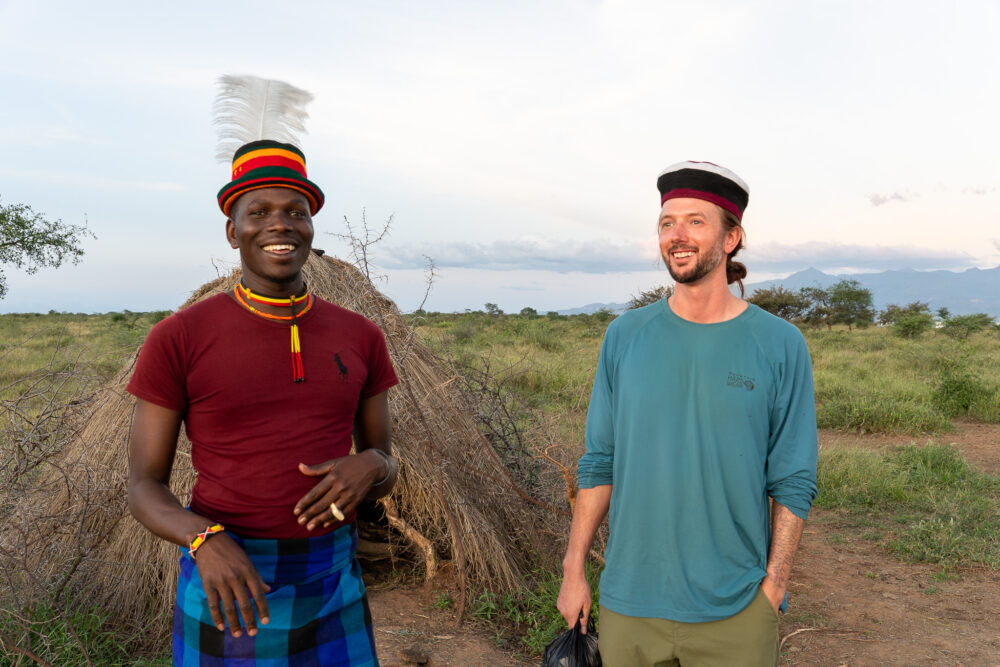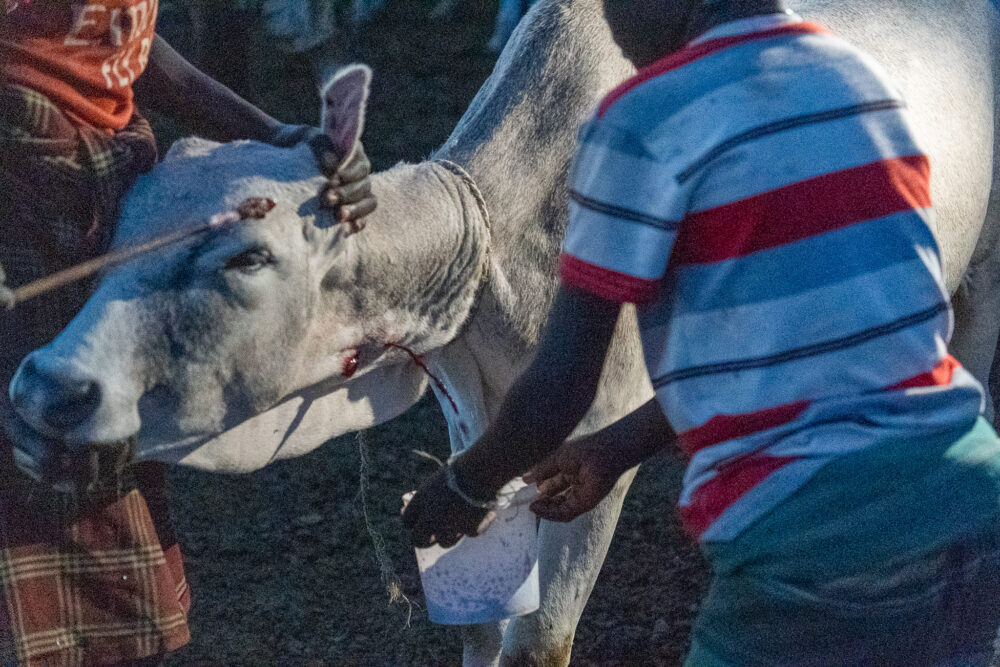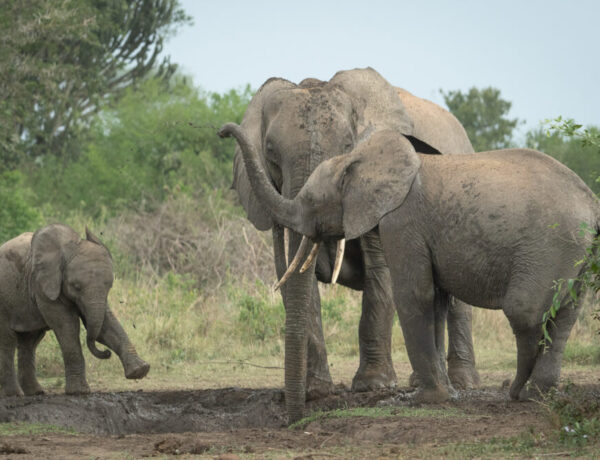This post may contain affiliate links. This just means I may receive a small commission at no extra cost to you for helping them promote their product or service. I don’t endorse any services I don’t personally use or recommend.
I was hesitant to visit any of the East African tribes. Don’t get me wrong, I wanted to learn about the cultures and experience another way of life. Still, it evoked images of locals being herded into groups for exuberantly dancing welcome parties decked out in regal outfits usually only worn for festive occasions and then me being unceremoniously herded hut-to-hut held hostage to purchase trinkets. Something very akin to a Disneyland tourist trap, only “Africa-themed.” We wanted to meet a tribal community— to learn another way of living and better understand a culture that could potentially be erased by the passage of time. But we didn’t want them to be forced into a staged performance for us or treat us as a walking ATM.
So, we searched for an ETHICAL and IMMERSIVE tribal experience in East Africa. We landed on a visit to Uganda’s Karamoja with its 500,000-strong population. While less globally recognizable than the Maasai, they had many similarities and likely stemmed from the same ancient pastoral ancestors in Ethiopia.


Our two days spent in Karamojong territory were some of the most eye-opening and interesting during our entire 1-month road trip through Uganda. And I felt it held up to my hopes of being a raw and unfiltered glimpse at tribal life. Fortunately, this is an experience that you can easily replicate. Thanks to a very special local organization that is hoping to help introduce north Uganda’s sparse travelers to the tribal community. (In no way was I hosted, sponsored, or profited in any form by visiting/writing this.)
Let’s dig into everything you need to know about planning a Karamoja tribe visit in Uganda.
READ MORE: Your Ultimate 1-Month Self-Driving Uganda Itinerary
Why Visit the Karamoja Tribe in Uganda?
Let’s start here. Why visit.
- An opportunity to experience tribal life in Eastern Africa + better understand another way of life.
- Sleep in a traditional boma.
- Learn about their rich cultural traditions firsthand, like the blood-letting of the cattle at the Kraal.
- Contribute to the preservation of a unique + ancient culture.
- Enjoy a truly special experience that connects you to the people on the continent, not just the wildlife.

A Quick Synopsis of Who Exactly the Karamoja Are
They are semi-nomadic cattle herders who live a subsistence lifestyle off the barren land of Northeast Uganda. Historically, the Karamoja have been heavily persecuted and discriminated against in Uganda, and this still carries over a little today. They are easily identifiable by their dress and are the most populous tribal group in all of Uganda.


Where are the Karamoja Located?
While they are located all over the sparsely populated landscape of Eastern Uganda, they are heavily concentrated in the areas of Kidepo National Park (my favorite camping park in Uganda) and Moroto. Moroto is often referred to as Karamoja town, and it is here in the shadow of Mount Moroto that most travelers plan their Karamoja tribal visit.
Map of Karamojong Region

Is it Karamoja? Karamojong? Karamoya?
You’ll see all three of these terms used somewhat interchangeably on the internet when discussing the group. They all reference the same people, and none of them are incorrect.
How to Plan a Karamoja Tribe Visit
For this exceptional experience, I am directing you to Karatunga Tours. They are based in the town of Moroto, where all tribal excursions are based. While the region stretches from Kidepo Valley to Sipi Falls, there are a few other places from where you can easily plan your visit.
I suggest contacting them via email well in advance if you want to visit a tribe nearby Kidepo Valley instead.
Michael’s WhatsApp Number (Lead Guide): +256 774 545653

Karatunga Tours is run by a Karamoja woman and her Dutch husband. They are dedicated to empowering the Karamoja community and encouraging travelers to engage in Uganda’s indigenous culture rather than just visit for the wildlife. But yes, Uganda’s wildlife destinations are incredible.
But so are the tribal regions.
How Much Does an Overnight Karamoja Tribe Visit Cost?
On the Karatunga website, you can plainly see the different options and their prices. We booked in person, and the prices were no different.
We paid $70 per person to visit the Kraal and stay overnight in the Karamoja Village. This, in our opinion, is the best experience available. While daytime village visits are the most popular, you won’t get to experience much alone time with the tribe and chat with them candidly around the fire. It will be a much more typical visit.
READ MORE: Does A Self-Drive Safari ACTUALLY Save You Money?
Where Does The Money From Your Visit Go?
All the money goes to the local guide you’ll be assigned and the Karatunga village that you visit. The local community uses this monetary donation to improve their life, get medicine for the cows & kids, and ease the burden of growing all their own crops. In times of drought and hardship, with this money, they will survive. It also goes to schooling for the few kids (like our guide Michael) who attend school in the nearby town of Moroto.

Is there a Cheaper Alternative?
At first, we tried to find a more budget-friendly way to visit the tribes. But soon enough, I realized that all local guides associated with the Karamoja were working with Karatunga Tours. After learning more about the company, we felt our money was going to a good cause and after our visit, we are SURE of that.
There is no ethical budget-friendly way of visiting. As the Karamoja don’t speak English and the Kraal is in a perpetual state of motion you would need to have your own car and just drive around aimlessly until you found them. Once you arrived, you would have nothing to say or do besides ogle at someone in their own house. Which is weird— don’t do that.
The benefit of visiting with a reputable guide/organization is that money actually goes to support the community you are visiting. This makes them much more open to random visitors coming into their village.
The bottom line is they should get something out of your invasion of their privacy.
READ MORE: Self-Driver’s Guide to Queen Elizabeth National Park in Uganda
Karamoja Tribe Visit Itinerary: What to Expect
Not all Karamoja Tribe visits are created equal. You can simply pay a small fee and drop in for a few hours visit in the middle of the day. In fact, that’s how the vast majority of travelers to East Africa visit tribal communities. This won’t give you much of a look at local life though. But if you plan your Karamoja Tribe Visit to extend overnight, you’ll have a much more meaningful experience for you and the tribal community. Here’s the itinerary I recommend instead.
Itinerary Summary
- Afternoon visit to the Kraal
- Dinner with the community at the village
- Stay overnight in a boma in the village
- Morning village walkabout
- Return to Moroto for breakfast
Overnight visitors to their village can witness the daily village life, eat dinner with them (usually consisting of a gritty blood red sorghum paste and greens), drink locally brewed beer, and see firsthand what it’s like to sleep in a traditional boma.


You can also head to the Kraal. This is where most of the cattle are kept to graze and are tended by young boys and a few men full-time. This is where the nomadicness of the Karamoja comes into play. Forced to move with the grazing, the Kraal have a rough life, and they consume the blood and milk of cows in a ritualistic “blood-letting” ceremony each evening to sustain themselves in this unforgiving landscape. You’ll get to witness this bloodletting and even try the mixture if you’re keen during a visit to the Kraal.


The Karamoya have an incredibly rich culture that leaves A LOT for the traveler to learn. We chatted with our translator long into the night, and I feel it’s best to go and talk with the Karamoja for yourself rather than dumping all that information here.
Another unexpected benefit? An incredible unobstructed view of stars far from light pollution.
Our Karamoja Tribal Visit Experience
We left mid-afternoon from the Karatunga Camp in our own vehicle (it costs extra if you require a driver) and headed straight for the Kraal.

This patch of barren dirt was where the men slept and lived while the cattle grazed. At dusk, the cows and their herders returned for the bloodletting and consumption. Then, it was on to the village at nightfall. At the village, we met the elders and sat around a campfire, drinking beer and eating dinner. After dinner, we talked via our guide and translator about life in America, and they told us about their lives here. After a lengthy discussion on women’s roles in society, we went to bed and, in the morning, got a full village tour and chatted with more of the women.



Then, it was back to Moroto and some breakfast at Karatunga.
Tips for Your Karamoja Tribal Visit
There are a few things you should consider before your visit to make it a little more comfortable for you.
You should not do this on an evening you are tired. You’ll spend most of your time talking with members of the tribe so you should be prepared to be engaged in conversation.
2. Bring some gifts.
Obviously, this is a suggestion, but we asked our guide beforehand what we could bring to the tribe to make their lives a little easier. He told us tobacco from the market, soap, salt for cooking, and candies or biscuits for the kids. I can tell you all these things were definitely appreciated, and you’ll just be sad you didn’t bring more. Most of these kids have only had candies a few times in their life and spend their day working in the sun, so I don’t really want to hear about “oh don’t give them candy—it’s bad for their teeth” nonsense.
3. Pack a sleeping bag and liner or sheet to cover yourself
The boma will be outfitted with a small mattress to make life more comfortable for you but you’ll need your own sleeping stuff. Karatunga can arrange it for you if you don’t have it. We were road-tripping, so we had pillows and gear. The sheet is for protection from the dust that seems to settle and fall on you at night. It will help you sleep.


4. Choose between local and foreign food.
Michael asked us before we left if we would prefer to eat as the Karamoja do or bring something more western. We chose the local meal. To be perfectly candid, it was very difficult to eat and not something I would choose to eat again, BUT it was an experience I wouldn’t change. I think that it’s all part of the experience when visiting the Karamoja Tribe. I was just very hungry when I returned to town.
5. Drink the cow blood.

Just not a lot. We did and didn’t get sick. I recommend packing some Pepto Bismol tablets to take afterward just to settle your stomach.
What Makes a Tribal Experience Ethical?
It can be hard to discern in East Africa whether an experience you book is good for the communities you’re visiting. In the southern half of Uganda, many companies exploit Indigenous communities like the Bantu pygmies while continuing to disenfranchise them. When dealing with humans and animals, it’s important to choose ethical experiences that enrich and better the lives of the beings you’re there to see.
I believe an ethical tribal experience treats the community with respect, puts money directly into the hands of the tribal people you visit, and offers the opportunity for real cultural exchange. Karatunga Tours definitely lived up to that standard.
We thoroughly enjoyed visiting the Karamojong region and learning about the Karamoja people. In fact, it later inspired a similar visit to the Hadzabe and Datoga tribes of Tanzania. Feel free to browse my Instagram highlights or shoot me a message for more information about visiting Uganda’s most populous tribe ethically!
Save This Karamoja Tribe Visit for Later!







No Comments